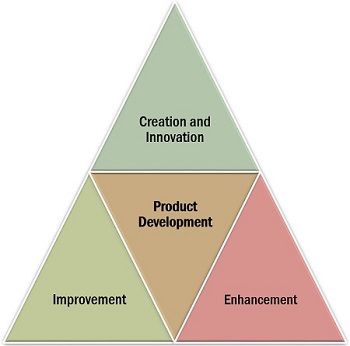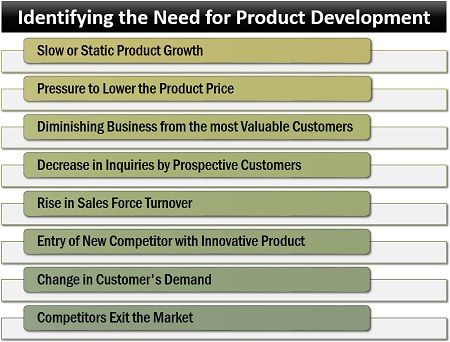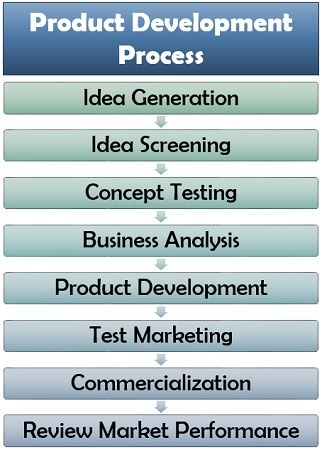Definition: Product development refers to the creation of a new product which has some utility; or up-gradation of the existing product; or enhancement of the production process, method or system. In simple words, it is all about bringing a change in the present goods or services or the mode of production.
In simple terms product development comprises of the following elements:
- Creation and Innovation pave the way for new inventions and generation of a new product which provides utility to the consumers.
- Improvement of the existing products is essential to upgrade the old products and to attain perfection.
- Enhancement of the existing production process, methods, techniques and system helps in the betterment of customer experience. It is more cost-efficient for the organization too.
For Example; One of the most popular electronic brands Sony came up with the idea of coloured television in the year 196o. Sony, with its new product development, has given a modern edge to the technological advancement in the entertainment world.
Content: Product Development
Identifying the Need for Product Development
Have you ever wondered; Why is the change needed in organizations? Why do the companies keep on modifying their ways? What makes companies invest a tremendous amount in research and development?
To answer these questions, let us go through the following reasons for which companies plan for product development:
Slow or Static Product Growth
When the company notices a downfall in the product performance regularly, which is not due to change in the economy or other factors which are beyond control, it should inspect the product line to find out the reason.
Pressure to Lower the Product Price
A business which is controlled merely by the price factor may land nowhere. If a company encounters that the customers are shifting to the competitors’ product due to the price factor and land up cutting down the prices of its product, it must opt for product development.
Diminishing Business from the Most Valuable Customers
The company finds out that its high revenue-generating customers prefer the competitor’s product over its product. Then, it must analyze the change in the customer’s demand and the features offered by the competitor’s product to meet that requirement.
Decrease in Inquiries by Prospective Customers
A product itself has the capability of acquiring customers. If the product becomes obsolete or unworthy for its buyers and is unable to attract inquiries from the potential customers, the company must consider product development.
Rise in Salesforce Turnover
When it becomes difficult for the sales team to sell a particular product to the customers, they tend to grab better opportunities in other companies. This leads to salesforce turnover. It signifies that something is wrong with the product due to which it is being rejected in the market.
Entry of New Competitor with Innovative Product
A new competitor enters the market and successfully acquires the company’s prevailing market share. The company needs to analyze that the competitor’s innovative product is providing a higher level of satisfaction to the customers, which the company’s product failed to do.
Change in Customer’s Demand
When the company finds out that the customers are frequently demanding a particular change in the product or seeking for some additional feature which the competitor is offering at the similar price, it should look forward to product development.
Competitors Exit the Market
Sometimes, many competitors leave the market since they have sensed the downfall. At this point, the company must look up to product development to retain the customers through innovation.
Product Development Process
Product development is a strategic approach. It should be well planned and systematically executed to achieve desired results and avoid loss.
Given below is the step by step process for introducing a new product in the market:
Idea Generation: The first step is knowing customer’s requirement through market research by taking feedback, conducting surveys and going through the competitor’s product. From this research, a product idea is developed.
Idea Screening: The product idea is to be well studied and investigated to find out the need for introducing the new product, the requirement of additional machinery, selection of marketing channel and its break-even point.
Concept Testing: The next stage is enquiring about the product feasibility by conducting concept testing. The new product idea is revealed to a group of consumers, and they are asked to share their response over it. If the majority is in favour of the product, then further steps are to be taken.
Business Analysis: In this step, the organization decides whether the product is financially viable for it or not. Product’s demand, cost, competitiveness, profitability, expected sales, overheads, etc. are analyzed.
Product Development: At this stage, the manufacturing of a new product, it’s financing, marketing and distribution as well as advertisement and promotion takes place. However, initially, a small quantity is produced as a test batch.
Test Marketing: The product is then launched in the market on a small scale. If it attains success and can generate customers, the large-scale production is planned.
If the product is rejected in the market, the company finds out the shortcomings and rectifies it. If the product fails again in the market, the company tends to dump it.
Commercialization: At this point, the company executes large-scale production and distribution of the successful new product. It advertises and markets the product on a massive scale to acquire a considerable customer base.
Review Market Performance: Lastly, the company keeps track of the product’s performance in the market to know customer satisfaction level, demand, profitability, sales volume, competitor’s strategy, the satisfaction of the middlemen involved, etc.
Conclusion
Product development is essential for the growth of all; the business, the consumers and the economy. No business can survive the competition without adding the element of innovation to its product line.
Developing a successful product for the consumers require a lot of brainstorming, planning, research, trials and rectification.
Zoe Campos says
I understand now how one must prepare carefully and test ideas before making them happen in the realm of product development. I found it interesting to know that the process of product development includes concept testing and ensuring product feasibility to different consumers. I’ll make sure to send this as a reference for anyone who might be interested in product prototype development in the future.